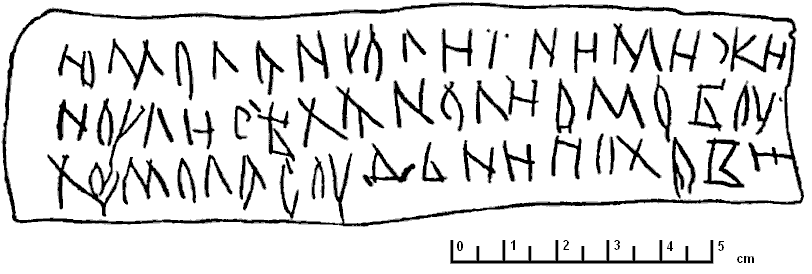Biology:Birch bark letter no. 292
The birch bark letter given the document number 292 is the oldest known document in any Finnic language. The document is dated to the beginning of the 13th century. It was found in 1957 by a Soviet expedition led by Artemiy Artsikhovsky in the Nerevsky excavation on the left coast side of Novgorod.[1] It is currently held at the Novgorod City Museum.
The language used in the document is thought to be an archaic form of Livvi-Karelian, the language spoken in Olonets Karelia,[2] although the exact form is difficult to determine, as Finnic dialects were still developing during that period.
Transcription
The text is written in Cyrillic in the Karelian dialect of the archaic Finnic language. A transcription of the text is as follows:
- юмолануолиїнимижи
- ноулисѣханолиомобоу
- юмоласоудьнииохови
Interpretations
By Yuri Yeliseyev
The text, as transliterated to the Latin alphabet by Yuri Yeliseyev in 1959[3] and interpreted in modern Finnish:
jumolanuoli ï nimizi
nouli se han oli omo bou
jumola soud'ni iohovi
Jumalannuoli, kymmenen [on] nimesi
Tämä nuoli on Jumalan oma
Tuomion-Jumala johtaa.
In English, this means roughly the following:
God's arrow, ten [is] your name
The Doom-God leads.
This arrow is God's own
Yeliseyev believes, that this is an invocation against lightning, as evidenced by "ten your names" construction. According to superstitious notions, knowledge of the name gives a human the magic power over an object or phenomenon.[4]
By Martti Haavio
As the orthography used does not utilize spaces between words, the source text can be transcribed into words in different ways. Martti Haavio gives a different interpretation of the text in his 1964 article, suggesting, that this is a sort of an oath:
jumolan nuoli inimizi
nouli sekä n[u]oli omo bou
jumola soud'nii okovy
In modern Finnish, this means roughly the following:
Jumalan nuoli, ihmisen
nuoli sekä nuoli oma.
Tuomion jumalan kahlittavaksi.
In modern Estonian, this means roughly the following:
Jumala nool, inimese
nool ja nool omaenda.
Kohtujumala aheldatuks.
In English, this means roughly the following:
God's arrow, man's
To be chained by the Doom-God.]
arrow, and (his) own arrow. [
By Yevgeny Khelimsky
Professor Yevgeny Khelimsky in his 1986 work[5] criticizes Haavio's interpretation and gives the third known scientific interpretation, believing the letter to be an invocation, like Yeliseyev:[4]
Jumalan nuoli 10 nimezi
Nuoli säihä nuoli ambu
Jumala suduni ohjavi (johavi?)
A translation into Finnish of this interpretation would look something like this:
Jumalan nuoli 10 nimesi
Nuoli säihkyvä nuoli ampuu
Suuto-Jumala (Syyttö-Jumala)† ohjaa (johtaa?)
In English, it means roughly the following:
God's arrow, ten your name(s)
The Doom-God guides/directs (leads/rules?)
Arrow sparkling, arrow shoots
†Syyttö-Jumala could also mean "Blaming God" or "God that blames"; modern Finnish syyttää = to blame or prosecute.
See also
References
- ↑ А.В. Арциховский, В.И. Борковский. Новгородские грамоты на бересте (из раскопок 1956–1957 гг.). М.: Из-во Акад. Наук СССР, 1963.
- ↑ Itämerensuomalaista kirjoitusta 1200-luvulta (in Finnish)
- ↑ Елисеев Ю. С. Древнейший письменный памятник одного из прибалтийско-финских языков.— Изв. АН СССР. Отд-ние лит. и языка, 1959, т. 18, Вып. 1, с. 65—72.
- ↑ 4.0 4.1 Written information on Karelians by S. I. Kochkurkina, A. M. Spiridonov, T. N. Jackson, 1996
- ↑ Хелимский Е. А. О прибалтийско-финском языковом материале в новгородских берестяных грамотах. In the book Янин В. Л., Зализняк А. А. Новгородские грамоты на бересте (из раскопок 1977—1983 гг.): Комментарии и словоуказатель к берестяным грамотам (из раскопок 1951—1983 гг.) / АН СССР. Отд-ние истории. — М.: Наука, 1986. — С. 254—255.)
Sources
- Jelisejev, J. S. Vanhin itämerensuomalainen kielenmuistomerkki, Virittäjä-lehti 1961: 134
- Jelisejev, J. S. Itämerensuomalaisia kielenmuistomerkkejä (Zusammenfassung: Ostseefinnische Sprachdenkmäler), Virittäjä-lehti 1966: 296 [1]
- Martti Haavio The Letter on Birch-Bark No. 292, Journal of the Folklore Institute, 1964. JSTOR 3814030
- Haavio, Martti, Tuohikirje n:o 292. Vanha suomalaisen muinaisuskonnon lähde, Virittäjä-lehti 1964: 1 [2]
External links
- (in Russian) Birch bark letter no. 292 (includes a photo and references) - at the website on Russian birch bark letters
- (in Finnish) Tuohikirje 292
- (in Finnish) Vielä kerran itämerensuomen vanhimmista muistomerkeistä - with (English) summary following references
 |



